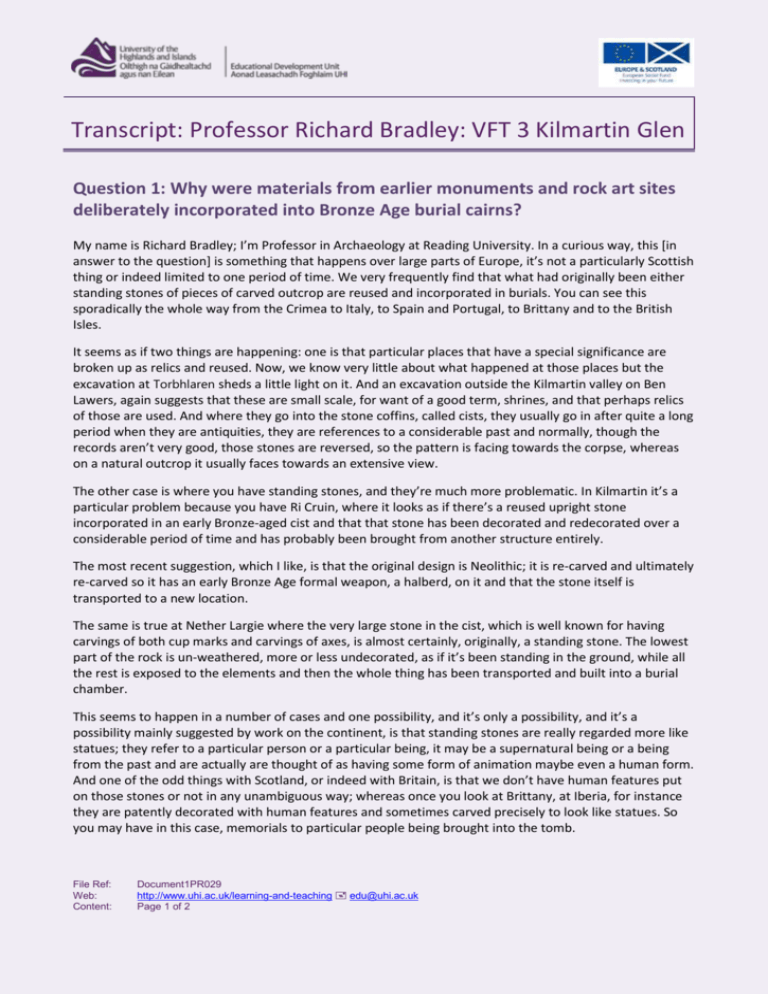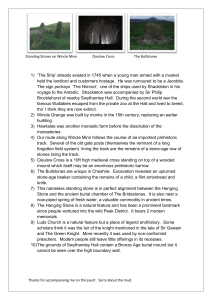Transcript: Professor Richard Bradley: VFT 3 Kilmartin Glen
advertisement

Transcript: Professor Richard Bradley: VFT 3 Kilmartin Glen Question 1: Why were materials from earlier monuments and rock art sites deliberately incorporated into Bronze Age burial cairns? My name is Richard Bradley; I’m Professor in Archaeology at Reading University. In a curious way, this [in answer to the question] is something that happens over large parts of Europe, it’s not a particularly Scottish thing or indeed limited to one period of time. We very frequently find that what had originally been either standing stones of pieces of carved outcrop are reused and incorporated in burials. You can see this sporadically the whole way from the Crimea to Italy, to Spain and Portugal, to Brittany and to the British Isles. It seems as if two things are happening: one is that particular places that have a special significance are broken up as relics and reused. Now, we know very little about what happened at those places but the excavation at Torbhlaren sheds a little light on it. And an excavation outside the Kilmartin valley on Ben Lawers, again suggests that these are small scale, for want of a good term, shrines, and that perhaps relics of those are used. And where they go into the stone coffins, called cists, they usually go in after quite a long period when they are antiquities, they are references to a considerable past and normally, though the records aren’t very good, those stones are reversed, so the pattern is facing towards the corpse, whereas on a natural outcrop it usually faces towards an extensive view. The other case is where you have standing stones, and they’re much more problematic. In Kilmartin it’s a particular problem because you have Ri Cruin, where it looks as if there’s a reused upright stone incorporated in an early Bronze-aged cist and that that stone has been decorated and redecorated over a considerable period of time and has probably been brought from another structure entirely. The most recent suggestion, which I like, is that the original design is Neolithic; it is re-carved and ultimately re-carved so it has an early Bronze Age formal weapon, a halberd, on it and that the stone itself is transported to a new location. The same is true at Nether Largie where the very large stone in the cist, which is well known for having carvings of both cup marks and carvings of axes, is almost certainly, originally, a standing stone. The lowest part of the rock is un-weathered, more or less undecorated, as if it’s been standing in the ground, while all the rest is exposed to the elements and then the whole thing has been transported and built into a burial chamber. This seems to happen in a number of cases and one possibility, and it’s only a possibility, and it’s a possibility mainly suggested by work on the continent, is that standing stones are really regarded more like statues; they refer to a particular person or a particular being, it may be a supernatural being or a being from the past and are actually are thought of as having some form of animation maybe even a human form. And one of the odd things with Scotland, or indeed with Britain, is that we don’t have human features put on those stones or not in any unambiguous way; whereas once you look at Brittany, at Iberia, for instance they are patently decorated with human features and sometimes carved precisely to look like statues. So you may have in this case, memorials to particular people being brought into the tomb. File Ref: Web: Content: Document1PR029 http://www.uhi.ac.uk/learning-and-teaching edu@uhi.ac.uk Page 1 of 2 Transcript: Professor Richard Bradley: VFT 3 Kilmartin Glen 07/02/13 Then at Kilmartin there’s actually a third complication and I think it may be a complication that is peculiar to Kilmartin, I simply haven’t thought about this enough, and that is that some of the settings of standing stones with cups and rings and cup marks, appear to have been prised off existing outcrops. And since often they’re only decorated on one side, it may well be that the stone was decorated long before it was removed, and so some of the settings of standing stones may consist of recycled pieces of rock art, where the decoration is considerably older than the stone setting itself. And that would certainly be consistent with what we’re learning about the chronology of carvings, that they start in the Neolithic period, perhaps as early as 3000 BC but some, and I stress there’s not much evidence, some of the stone alignments we find on the west coast may be as late as 1200 or even 1000 BC and they may consist of relics in the same way as those that are in the tombs. So there’s a considerable attempt I think to take things that are significant, ancient, have particular meanings, perhaps particular associations with specific people and to incorporate them in the tomb; and it’s possible, though we certainly can’t prove it, that the same might apply to other forms of monument. I’ve always been suspicious of the decorated stones in the larger stone circle at Temple Wood and whether they had been brought form some other monument or some other location. I certainly don’t think we can prove this. File Ref: Web: Content:: Document1 http://www.uhi.ac.uk/learning-and-teaching edu@uhi.ac.uk Page 2 of 2










